Michael J. Behe's Blog, page 444
August 12, 2019
Eric Holloway: Are transgenic monkeys – with some human genes – partly human?

A correspondent asks, If the transgenic monkeys are, as reported, somewhat smarter than other macaques, do they have minds and souls?
I’m not sure that improved memory and processing speed means that the macaques are more humanlike. A computer has much greater memory and processing speed than a human and I would not give the computer even animal rights.
Of course, the real question is, what is the dividing line between animals and humans? I think the above argument shows at least that it is not memory or processing speed.
Another way to think about it is this: What if implanting macaque genes in a mouse makes the mouse smarter? Does that mean the mouse is more human-like? What if the genes of some animals, such as crows, dolphins or elephants, which are considered smarter than macaques in certain respects, are used to make the macaques smarter? Does that mean the macaque is more human-like, or more like these other animals?
Eric Holloway, “Are monkeys with some human genes partly human?” at Mind Matters News
See also: Eric Holloway’s earlier discussions with Querius:
Could AI think like a human, given infinite resources? Given that the human mind is a halting oracle, the answer is no.
The flawed logic behind “thinking” computers, Part I A program that is intelligent must do more than reproduce human behavior
The flawed logic behind “thinking” computers, Part II There is another way to prove a negative besides exhaustively enumerating the possibilities.
and
The flawed logic behind “thinking” computers, Part III No program can discover new mathematical truths outside the limits of its code.
Note: “Querius” is a pseudonym.
Follow UD News at Twitter!
Copyright © 2019 Uncommon Descent . This Feed is for personal non-commercial use only. If you are not reading this material in your news aggregator, the site you are looking at is guilty of copyright infringement UNLESS EXPLICIT PERMISSION OTHERWISE HAS BEEN GIVEN. Please contact legal@uncommondescent.com so we can take legal action immediately.
Plugin by Taragana
Artificial vs human intelligence: Sabine Hossenfelder offers us 10 differences

Theoretical physicist Hossenfelder, the author of Lost in Math: How Beauty Leads Physics Astray, includes
10. Precision
The human brain is much more noisy and less precise than a neural net running on a computer. This means the brain basically cannot run the same learning mechanism as a neural net and it’s probably using an entirely different mechanism.
A consequence of these differences is that artificial intelligence today needs a lot of training with a lot of carefully prepared data, which is very unlike to how human intelligence works. Neural nets do not build models of the world, instead they learn to classify patterns, and this pattern recognition can fail with only small changes. A famous example is that you can add small amounts of noise to an image, so small amounts that your eyes will not see a difference, but an artificially intelligent system might be fooled into thinking a turtle is a rifle.
Sabine Hossenfelder, “10 differences between artificial intelligence and human intelligence” at BackRe(Action)
As AI types like to say, the system is so easily fooled because it doesn’t “know” anything. We are slowly learning, in consequence, more about what it means for a human being to “know” something.
See what deep learning vision made of a teapot (golf ball?) How about the school bus as a punching bag?
See also: Sabine Hossenfelder dusts off superdeterminism.
Follow UD News at Twitter!
Copyright © 2019 Uncommon Descent . This Feed is for personal non-commercial use only. If you are not reading this material in your news aggregator, the site you are looking at is guilty of copyright infringement UNLESS EXPLICIT PERMISSION OTHERWISE HAS BEEN GIVEN. Please contact legal@uncommondescent.com so we can take legal action immediately.
Plugin by Taragana
“Descartes’ mind-body problem” makes nonsense of materialism

In the sense that materialists must talk nonsense to explain it away:
Our mind-body problem is not just a difficulty about how the mind and body are related and how they affect one another. It is also a difficulty about how they can be related and how they can affect one another. Their characteristic properties are very different, like oil and water, which simply won’t mix, given what they are. There is a very common view which states that the French philosopher René Descartes discovered, or invented, this problem in the 17th century…
What is characteristic of a mind, Descartes claims, is that it is conscious, not that it has shape or consists of physical matter. Unlike the brain, which has physical characteristics and occupies space, it does not seem to make sense to attach spatial descriptions to it. In short, our bodies are certainly in space, and our minds are not, in the very straightforward sense that the assignation of linear dimensions and locations to them or to their contents and activities is unintelligible. That this straightforward test of physicality has survived all the philosophical changes of opinion since Descartes, almost unscathed, is remarkable…
What happens, if anything, for example, when we decide to do even such a simple thing as to lift up a cup and take a sip of coffee? The arm moves, but it is difficult to see how the thought or desire could make that happen. It is as though a ghost were to try to lift up a coffee cup. Its ghostly arm would, one supposes, simply pass through the cup without affecting it and without being able to cause it or the physical arm to go up in the air.
Jonathan Westphal, “Descartes and the Discovery of the Mind-Body Problem” at Aeon
We all experience this. But the mind-body “problem” is the nonsense materialists are led into in order to make the obvious meaning of the experience of an immaterial mind disappear in a dense weed jungle of verbiage.
How they have tried to address the dilemma: Why some scientists believe the universe is conscious. They’re not mystics. But materialism is not giving good answers so they are looking around. These prominent thinkers are driven to panpsychism because materialism about the mind doesn’t really work. So if panpsychism ends up seeming absurd, dualism—there really is an immaterial world—is also worth considering.
Why some scientists think science is an illusion. It’s a useful illusion, they say, but our brains are not really wired to know the facts. The great triumph of the theory of evolution was to show that humans are just animals in nature—clever, yes, but clever animals. Or so we are told. But wait!
Panpsychism: You are conscious but so is your coffee mug
and
How can consciousness be a material thing? Well, as the materialist philosopher himself will explain, he must see it that way.)
Copyright © 2019 Uncommon Descent . This Feed is for personal non-commercial use only. If you are not reading this material in your news aggregator, the site you are looking at is guilty of copyright infringement UNLESS EXPLICIT PERMISSION OTHERWISE HAS BEEN GIVEN. Please contact legal@uncommondescent.com so we can take legal action immediately.
Plugin by Taragana
August 11, 2019
Recognizing design in nature as the standard for a reasonable person
That was an ancient philosophical world view:
There’s an assumption out there among many that a belief in design, as opposed to chance, as an explanation for everything we see around us is a religious claim that begins with the Bible.
But the truth is, people have been reasoning to the conclusion of intelligent design for millennia. One example of this is Cicero (106–43 BC), a Roman philosopher who wrote this in his On the Nature of the Gods: “Who would not deny the name of human being to a man who, on seeing the regular motions of the heaven and the fixed order of the stars and the accurate interconnection and interrelation of all things, can deny that these things possess any rational design, and can maintain that phenomena, the wisdom of whose ordering transcends the capacity of our wisdom to understand it, take place by chance? … ”
Amy K. Hall, “Intelligent Design Theory Is the Result of Reason, Not Dogma” at Stand to Reason
Pretty strong words. But from a classical perspective, seeing design was an act of reason and reason was the hallmark of humanity. The chief triumph of Darwinism is to make kinship with unreasoning creatures the hallmark of humanity. From there, it is a short step to seeing human consciousness as an illusion.
Science run by the raging Woke – who have no use for all this – will be, shall we say, an interesting place.
Copyright © 2019 Uncommon Descent . This Feed is for personal non-commercial use only. If you are not reading this material in your news aggregator, the site you are looking at is guilty of copyright infringement UNLESS EXPLICIT PERMISSION OTHERWISE HAS BEEN GIVEN. Please contact legal@uncommondescent.com so we can take legal action immediately.
Plugin by Taragana
Paper claiming kids’ religiosity decreased altruism retracted
RETRACTION| VOLUME 29, ISSUE 15, P2595, AUGUST 05, 2019 Retraction Notice to: The Negative Association between Religiousness and Children’s Altruism across the World Jean Decety, Jason M. Cowell, Kang Lee, Susan Malcolm-Smith, Bilge Selcuk, Xinyue Zhou, … DOI:https://doi.org/10.1016/j.cub.2019.07...
(Current Biology 25, 2951–2955; November 16, 2015) In our paper, we reported cross-cultural differences in how the religious environment of a child negatively impacted their sharing, their judgments of the actions of others, and how their parents evaluated them. An error in this article, our incorrect inclusion of country of origin as a covariate in many analyses, was pointed out in a correspondence from Shariff, Willard, Muthukrishna, Kramer, and Henrich
(https://doi.org/10.1016/j.cub.2016.06...). When we reanalyzed these data to correct this error, we found that country of origin, rather than religious affiliation, is the primary predictor of several of the outcomes. While our title finding that increased household religiousness predicts less sharing in children remains significant, we feel it necessary to explicitly correct the scientific record, and we are therefore retracting the article. We apologize to the scientific community for any inconvenience caused.More.
But what was the paper doing in a biology journal anyway? Maybe the underlying assumptions should be unpacked.
Then there’s the whole question of whether “altruism” is a bogus concept, developed for just these purposes.
Follow UD News at Twitter!
Copyright © 2019 Uncommon Descent . This Feed is for personal non-commercial use only. If you are not reading this material in your news aggregator, the site you are looking at is guilty of copyright infringement UNLESS EXPLICIT PERMISSION OTHERWISE HAS BEEN GIVEN. Please contact legal@uncommondescent.com so we can take legal action immediately.
Plugin by Taragana
Philosopher puts a positive spin on contemplating human extinction
A sign of maturity, he thinks:
The history of the idea of human extinction is therefore also a history of enlightening. It concerns the modern loss of the ancient conviction that we live in a cosmos inherently imbued with value, and the connected realisation that our human values would not be natural realities independently of our continued championing and guardianship of them …
So, human extinction could become meaningful (and thus a motivating target for enquiry and anticipation) only after value was fully ‘localised’ to the minds of value-mongering creatures. We had to realise that the Universe was not inherently a cradle of justice and morality. ‘Value’ and ‘fact’ had to be disentangled before we truly came to appreciate the potential fact of the end of value. Only through this were we first motivated to forecast, in order to redoubt human justice against an extrajudicial nature. It is such a dynamic that, across modernity, drags our concerns further and further into futurity, and continues to do so.
Thomas Moynihan, “The end of us” at Aeon
But the other half of the apple is that evolution utterly deludes us, remember?:
Why some scientists think science is an illusion. It’s a useful illusion, they say, but our brains are not really wired to know the facts. The great triumph of the theory of evolution was to show that humans are just animals in nature—clever, yes, but clever animals. Or so we are told. But wait!
So many scandals and impasses that science faces today stem in large part from the problem Moynihan avoids. Facts don’t validate themselves outside a structure that posits meaning from beyond the system. The system does not validate itself.
Copyright © 2019 Uncommon Descent . This Feed is for personal non-commercial use only. If you are not reading this material in your news aggregator, the site you are looking at is guilty of copyright infringement UNLESS EXPLICIT PERMISSION OTHERWISE HAS BEEN GIVEN. Please contact legal@uncommondescent.com so we can take legal action immediately.
Plugin by Taragana
August 10, 2019
In the Beginning…
Section 9.3 of my 2015 book In the Beginning and Other Essays on Intelligent Design summarizes the contents of the book in two paragraphs:
Science has been so successful in explaining natural phenomena that the modern scientist is convinced that it can explain everything, and anything that challenges this assumption is simply ignored. It doesn’t matter that there were no natural causes before Nature came into existence, so he cannot hope to ever explain the sudden creation of time, space, matter and energy and our universe in the big bang. It doesn’t matter that quantum mechanics is based on a “principle of indeterminacy” which tells us that every “natural” phenomenon has a component that is forever beyond the ability of science to explain or predict, he still insists nothing is beyond the reach of his science. When he discovers that all of the basic constants of physics, such as the speed of light, the charge and mass of the electron, Planck’s constant, etc., had to have almost exactly the values that they do have in order for any conceivable form of life to survive in our universe, he proposes the “anthropic principle” and says that there must be many other universes with the same laws, but random values for the basic constants, and one was bound to get the values right.
When you ask him how a mechanical process such as natural selection could cause human consciousness to arise out of inanimate matter, he doesn’t understand what the problem is, and he talks about human evolution as if he were an outside observer, and never seems to wonder how he got inside one of the animals he is studying. And when you ask how the four fundamental forces of Nature alone could rearrange the basic particles of Nature into libraries full of encyclopedias, science texts and novels, and computers, connected to laser printers, LCDs and keyboards and the Internet, he says, well, order can increase in an open system.
A PDF version is now downloadable here.
Copyright © 2019 Uncommon Descent . This Feed is for personal non-commercial use only. If you are not reading this material in your news aggregator, the site you are looking at is guilty of copyright infringement UNLESS EXPLICIT PERMISSION OTHERWISE HAS BEEN GIVEN. Please contact legal@uncommondescent.com so we can take legal action immediately.
Plugin by Taragana
UD Newswatch: Epstein Suicide
After a reported suicide attempt July 23, disgraced millionnaire Jeffery Epstein is reported to have committed suicide in his cell in Manhattan, New York. Daily Mail’s bullet-point summary:

Drudge “in red” headers list:

This comes just one day after May 3, 2016 testimony of Veronica Roberts Giuffre was unsealed. According to DM ” Giuffre alleged that she was trafficked by Epstein and Maxwell to have sex with and provide erotic massages for politicians and affluent businessmen.” (NB: For the record, she specifically denies being sexually involved with either former US President Clinton or present President Trump.)
This disturbing development is all the more questionable as Mr Epstein would have been a high profile prisoner at risk of both being murdered and committing suicide. He should have been under close guard and after the earlier incident he should have been under suicide watch.
This development is bound to feed all sorts of speculations about corrupt, ruthless global power elites. In that context, it is advisable to bear in mind straight vs spin principles:
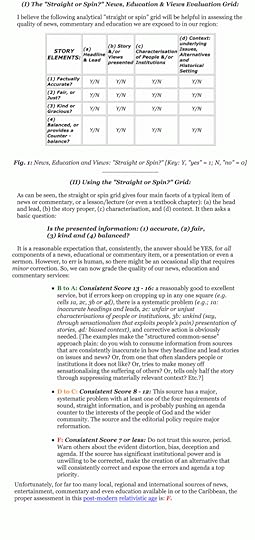
Let us soberly reflect on this tragic development. END
Copyright © 2019 Uncommon Descent . This Feed is for personal non-commercial use only. If you are not reading this material in your news aggregator, the site you are looking at is guilty of copyright infringement UNLESS EXPLICIT PERMISSION OTHERWISE HAS BEEN GIVEN. Please contact legal@uncommondescent.com so we can take legal action immediately.
Plugin by Taragana
Gunter Bechly on the media that teach nonsense about evolution
And the nonsense is not often corrected:
In the summer of 2018, PBS Eons published Episode 46 of Season 1, “When Fish First Breathed Air.” Since then the video has amassed a staggering 805,000 views. When I first watched it last year, I was unpleasantly surprised, even shocked. At timecode 5:50-6:05 they claim as the central thesis of their video that lungs evolved from the fish swim bladder. This is such a stupid error that I thought it would certainly be corrected soon and the comments section would likely explode with critical remarks by educated viewers. Boy, was I wrong! A year passed and nothing happened. No correction and not a single comment on this issue. Same at their Facebook posting of this embarrassing video. So it falls to Darwin critics to point out the error.
Here is what modern evolutionary biology actually says about lung origins. The swim bladder and lungs are indeed considered to be similar, both having derived from an outpocketing of the gut (Perry et al. 2001, Longo et al. 2013). However, contrary to the erroneous beliefs of Charles Darwin, lungs are no longer considered to have evolved from the swim bladder. Actually, because of the different ontogenetic origins of lungs as a paired ventral and the swim bladder as an unpaired dorsal outpocketing of the gut, even their homology is questionable (Daniels et al. 2004). Paired lungs are present not only in land vertebrates and lobe-finned fish like lungfish, but also in primitive ray-finned fish like the reedfish and bishirs (Polypteriformes) (Icardo et al. 2017). Therefore they are generally considered to belong to the common ground-plan of bony fish in general. Another group of lobe-finned fish, the coelacanths, has a vestigial lung and a so-called “fatty organ” that may correspond to the other half of a paired lung (Lambertz 2017), but coelacanths possess no swim bladder. The more primitive sharks and rays lack lungs as well as swim bladders. Swim bladders are restricted to ray-finned fish (Actinopterygii), and are thus considered as a uniquely derived character within this group, apart from the most basal and relictual order Polypteriformes mentioned above (Hughes et al. 2018). The claim in the PBS video (timecode 6:02-6:06) that ancestors of early tetrapods like Tiktaalik and Ichthyostega probably had a swim bladder is complete rubbish.
Günter Bechly, “PBS Eons Teaches Nonsense about Evolution” at Evolution News and Science Today
The media can’t really help teaching nonsense about evolution and they will definitely resist correction, putting it down to some dark creationist plot. That is because so much of it supports their worldview. Which may well reflect on their worldview.
The good news is that there are many alternatives within easy reach today, more in line with the facts. People who are still listening to stuff that was mandated by the Darwin-in-the-schools lobby for grade school usually don’t know, it’s true, or else don’t care or have made a choice.
Another argument, it seems, for independent schools.
See also: Nice to see Gunter Bechly’s name It’s not even just heroes we want to see vindicated but ordinary joes and jills who can go about their business while saying, “I see plenty wrong with the dominant theory today.” Physicists are allowed that but biologists aren’t. That’s because Darwinism functions very much as a religion for Darwinians.
Paleontologist Gunter Bechly Live Tonight On What The Fossil Record Really Tells Us About Common Ancestry
Gunter Bechly: Decline of science? Imaged in a single paragraph
Gunter Bechly: Living fossils under massive attack
Gunter Bechly: New Human Find In The Philippines = New Headache For Darwinism
Fossil dragonfly named has implications for ID
Logic vs. the multiverse: Gunter Bechly offers some insights
What’s Gunter Bechly doing these days?
Paleontologist Gunter Bechly erased from Wikipedia
Fossil Discontinuities: A Refutation Of Darwinism And Confirmation Of Intelligent Design
Fossil dragonfly named in Mike Behe’s honor
and
Why a four-eyed fossil lizard is a problem for Darwinism (Bechly’s view)
Follow UD News at Twitter!
Copyright © 2019 Uncommon Descent . This Feed is for personal non-commercial use only. If you are not reading this material in your news aggregator, the site you are looking at is guilty of copyright infringement UNLESS EXPLICIT PERMISSION OTHERWISE HAS BEEN GIVEN. Please contact legal@uncommondescent.com so we can take legal action immediately.
Plugin by Taragana
Time’s arrow, the design inference on FSCO/I and the one root of a complex world-order (–> Being, logic & first principles, 25)
On August 7th, News started a discussion on time’s arrow (which ties to the second law of thermodynamics). I found an interesting comment by FF:
FF, 4: >> It’s always frustrating to read articles on time’s arrow or time travel. In one camp, we have the Star Trek physics fanatics who believe in time travel in any direction. In the other camp, we have those who believe only in travel toward the future. But both camps are wrong. It is logically impossible for time to change at all, in any direction. We are always in the present, a continually changing present. This is easy to prove. Changing time is self-referential. Changing time (time travel) would require a velocity in time which would have to be given as v = dt/dt = 1, which is of course nonsense. That’s it. This is the only proof you need. And this is the reason that nothing can move in spacetime and why Karl Popper called spacetime, “Einstein’s block universe in which nothing happens.” . . . >>
That set me to thinking, and I responded. The connexions involved in that response in turn lead to the core framework of the design inference. Accordingly, I think this goes to logic and first principles, given the fundamental character of physics and particularly of thermodynamics and its bridge to information:
KF, 6: >>a set of puzzles.
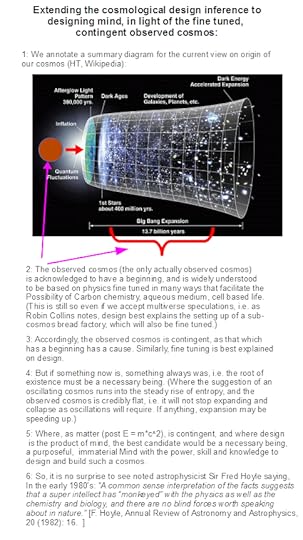
Obviously, we inhabit what we call now, which changes in a successive, causally cumulative pattern. Thus we identify past, present (ever advancing), future. In that world, there are entities that while they may change, have a coherent identity: be-ings.
As a part of change, energy flows and does so in a way that gradually dissipates its concentrations, hence time’s arrow. This flows from the statistical properties of phase spaces for systems with large [typ 10^18 – 26 and up] numbers of particles. Thus we come to the overwhelming trend towards clusters of microstates with dominant statistical weight. We can typify by pondering a string of 500 to 1,000 coins and their H/T possibilities. If you want a more “physical” analogue, try a paramagnetic substance with as many elements in a weak B-field that specifies alignment with or against its direction. We then see that overwhelmingly near 50-50 in H/T or W/A dominates in a sharply peaked binomial distribution.
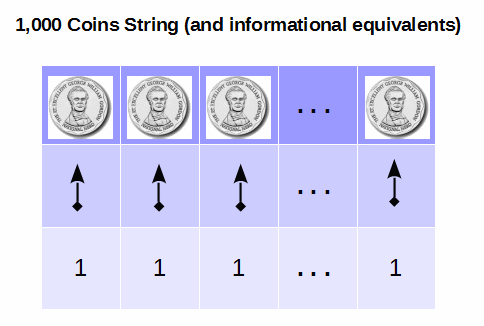
Thus, we may contemplate the 10^57 atoms of the Sol system (or the ~ 10^80 of the observed cosmos), each acting as an observer of a string of 500 coins (or, 1,000):
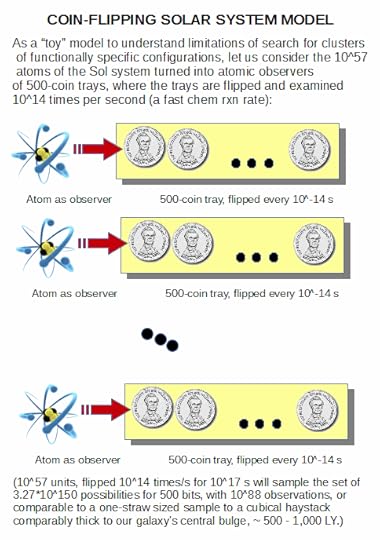
Thus we see the binomial distribution of coin-flipping possibilities, here based on 10,000 actual tosses iterated 100,000 times, also indicating just how tight the peak is, mostly being between 4,850 and 5,150 H:
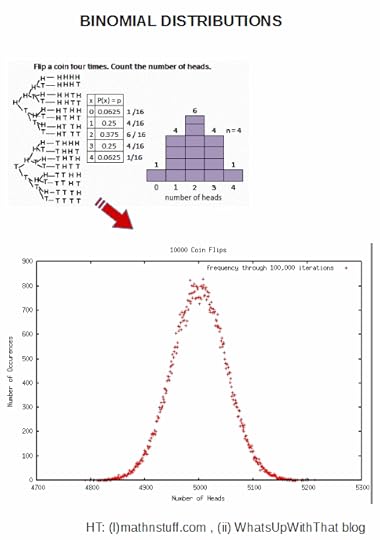
Thus we see the roots of discussions on fluctuations:

Note, not coincidentally, sqrt (10^4) = 10^2, or 100.
And, if the pattern of changes is not mechanically forced and/or intelligently guided, the resulting bit patterns overwhelmingly will have no particularly meaningful or configuration-dependent functionally specific, information-rich configuration. Indeed, this is another way of putting the key design inference that on this sort of statistical analysis, functionally specific, complex organisation and/or associated information (FSCO/I, the relevant subset of CSI) is a highly reliable index of intelligently directed configuration as material causal factor.
Where, too, discussion on such a binomial distribution is WLOG, as any state or configuration, in principle — and using some description language and universal constructor to give effect — can be specified as a sufficiently long bit string. Trivially, try AutoCAD and NC instructions for machines.
In particular, let us consider a von Neumann kinematic self replicator as both a machine with universal fabrication in principle and as a functional, information-rich highly organised component of the living cell with its own origin to be explained as the basis for reproduction in cell based life:
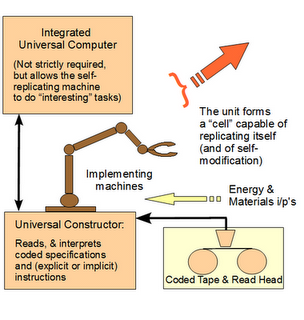
As a result, we see that Orgel is right:
>living organisms are distinguished by their specified complexity. Crystals are usually taken as the prototypes of simple well-specified structures, because they consist of a very large number of identical molecules packed together in a uniform way. Lumps of granite or random mixtures of polymers are examples of structures that are complex but not specified. The crystals fail to qualify as living because they lack complexity; the mixtures of polymers fail to qualify because they lack specificity . . . .
[HT, Mung, fr. p. 190 & 196:]
These vague idea can be made more precise by introducing the idea of information. Roughly speaking, the information content of a structure is the minimum number of instructions needed to specify the structure.
[–> this is of course equivalent to the string of
yes/no questions required to specify the relevant J S Wicken “wiring
diagram” for the set of functional states, T, in the much larger space
of possible clumped or scattered configurations, W, as Dembski would go on to define in NFL in 2002, also cf here,— here and
— here
— (with here on self-moved agents as designing causes).]
One can see intuitively that many instructions are needed to specify a complex structure. [–> so if the q’s to be answered are Y/N, the chain length is an information measure that indicates complexity in bits . . . ] On the other hand a simple repeating structure can be specified in rather few instructions. [–> do once and repeat over and over in a loop . . . ] Complex but random structures, by definition, need hardly be specified at all . . . . Paley was right to emphasize the need for special explanations of the existence of objects with high information content, for they cannot be formed in nonevolutionary, inorganic processes [–> Orgel had high hopes for what Chem evo and body-plan evo could do by way of info generation beyond the FSCO/I threshold, 500 – 1,000 bits.] [The Origins of Life (John Wiley, 1973), p. 189, p. 190, p. 196.]>
Thus, we come to the heart of why the design inference on FSCO/I is
so reliable: trillions of observed cases of its origin; uniformly,
caused by intelligently directed configuration.
So, the design inference has underpinnings in the informational view
of statistical thermodynamics, on which entropy is seen as a metric of
average missing information to specify particular microstate, given only
the macro-observable state. Thus, too, degree of randomness of a
particular configuration is strongly tied to required “minimum”
description length. A truly random configuration essentially has to be
quoted to describe it. A highly orderly (so, repetitive) one can be
specified as: unit cell, repeated n times in some array.
Information-rich descriptions are intermediate and are meaningful in
some language: language is naturally somewhat compressible but is not
reducible to repeating unit cells.
Consequently, the design inference on FSCO/I is robust.
We also recognise a space-time matrix and presence of fields so that
there is a context of interactions of beings in the common world.
However, simultaneity turns out to be an observer-relative
phenomenon, energy and information face a speed limit, c. Further,
massive bodies of planetary, stellar or galactic scale sufficiently warp
the space-time fabric to have material effects. Along the way, the
micro scale is quantised, leading also to a world of virtual particles
below the Einstein energy-time uncertainty threshold that shapes field
interactions and may have macro effects up to the level of cosmic
inflation and even bubbles expanding into sub-cosmi.
There are also issues of rationally free mind rising above what
computing substrates can do as dynamic-stochastic systems, interacting
with brains through quantum influences.
Reality is complex yet somehow unified — the first metaphysical
problem contemplated as a philosophical general issue in our
civilisation, the one and the many.
And that in turn points to the importance of the world-root that springs up into the causal-temporal, successive, cumulative order that we inhabit. >>
Walker and Davies add further insights:
In physics, particularly in statistical mechanics, we base many of our calculations on the assumption of metric transitivity, which asserts that a system’s trajectory will eventually [–> given “enough time and search resources”] explore the entirety of its state space – thus everything that is phys-ically possible will eventually happen. It should then be trivially true that one could choose an arbitrary “final state” (e.g., a living organism) and “explain” it by evolving the system backwards in time choosing an appropriate state at some ’start’ time t_0 (fine-tuning the initial state). In the case of a chaotic system the initial state must be specified to arbitrarily high precision. But this account amounts to no more than saying that the world is as it is because it was as it was, and our current narrative therefore scarcely constitutes an explanation in the true scientific sense.
We are left in a bit of a conundrum with respect to the problem of specifying the initial conditions necessary to explain our world. A key point is that if we require specialness in our initial state (such that we observe the current state of the world and not any other state) metric transitivity cannot hold true, as it blurs any dependency on initial conditions – that is, it makes little sense for us to single out any particular state as special by calling it the ’initial’ state. If we instead relax the assumption of metric transitivity (which seems more realistic for many real world physical systems – including life), then our phase space will consist of isolated pocket regions and it is not necessarily possible to get to any other physically possible state (see e.g. Fig. 1 for a cellular automata example).
[–> or, there may not be “enough” time and/or resources for the relevant exploration, i.e. we see the 500 – 1,000 bit complexity threshold at work vs 10^57 – 10^80 atoms with fast rxn rates at about 10^-13 to 10^-15 s leading to inability to explore more than a vanishingly small fraction on the gamut of Sol system or observed cosmos . . . the only actually, credibly observed cosmos]
Thus the initial state must be tuned to be in the region of phase space in which we find ourselves [–> notice, fine tuning], and there are regions of the configuration space our physical universe would be excluded from accessing, even if those states may be equally consistent and permissible under the microscopic laws of physics (starting from a different initial state). Thus according to the standard picture, we require special initial conditions to explain the complexity of the world, but also have a sense that we should not be on a particularly special trajectory to get here (or anywhere else) as it would be a sign of fine–tuning of the initial conditions. [ –> notice, the “loading”] Stated most simply, a potential problem with the way we currently formulate physics is that you can’t necessarily get everywhere from anywhere (see Walker [31] for discussion). [“The “Hard Problem” of Life,” June 23, 2016, a discussion by Sara Imari Walker and Paul C.W. Davies at Arxiv.]
Again, food for thought. END
PS: I followed up by searching and commented at 2 below. On reflection what is there is so pivotal that I append it as integral to the OP. And no, I do not have to endorse or even like the corpus of a thinker’s work in order to acknowledge where s/he has made a truly striking, powerfully penetrating point. We are invited to not despise “prophesyings,” but to test all things and hold on to the good. In that spirit:
KF, 2 below: >> . . . I find an interesting discussion on the one and the many:
One of the most basic and continuing problems of man’s history is the question of the one and the many and their relationship. The fact that in recent years men have avoided discussion of this matter has not ceased to make their unstated presuppositions with respect to it determinative of their thinking.
Much of the present concern about the trends of these times is literally wasted on useless effort because those who guide the activities cannot resolve, with the philosophical tools at hand to them, the problem of authority. This is at the heart of the problem of the proper function of government, the power to tax, to conscript, to execute for crimes, and to wage warfare. The question of authority is again basic to education, to religion, and to the family. Where does authority rest, in democracy or in an elite, in the church or in some secular institution, in God or in reason? . . . The plea that this is a pluralistic culture is merely recognition of the problem-not an answer. The problem of authority is not answerable to reason alone, and basic to reason itself are pre-theoretical suppositions or axioms1 which represent essentially religious commitments. And one such basic commitment is with respect to the question of the one and the many.2 The fact that students can graduate from our universities as philosophy majors without any awareness of the importance or centrality of this question does not make the one and the many less basic to our thinking. The difference between East and West, and between various aspects of Western history and culture, rests on answers to this problem which, whether consciously or unconsciously, have been made. Whether recognized or not, every argument and every theological, and philosophical, political, or any other exposition is based on a presupposition about man, God, and society-about reality. This presupposition rules and determines the conclusion; the effect is the result of a cause. And one such basic presupposition is with reference to the one and the many.
[ By R. J. Rushdoony April 24, 2017 Adapted from The One and the Many: Studies in the Philosophy of Order and Ultimacy ]
The one and the many, unity in coherent (and hopefully intelligible) diversity as a cosmos is absolutely pivotal. Including, on the force of the design inference i/l/o time’s arrow but also onward issues of the root of reality, the necessary and independent core from which all the diversity we see springs.
So, this question we must tackle, tackle in a fundamental way.>>
Copyright © 2019 Uncommon Descent . This Feed is for personal non-commercial use only. If you are not reading this material in your news aggregator, the site you are looking at is guilty of copyright infringement UNLESS EXPLICIT PERMISSION OTHERWISE HAS BEEN GIVEN. Please contact legal@uncommondescent.com so we can take legal action immediately.
Plugin by Taragana
Michael J. Behe's Blog
- Michael J. Behe's profile
- 219 followers



